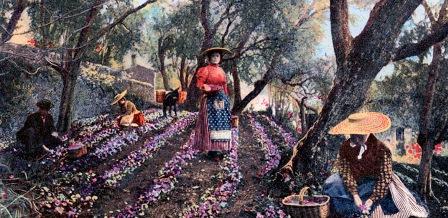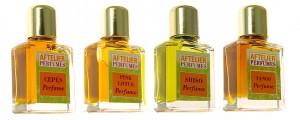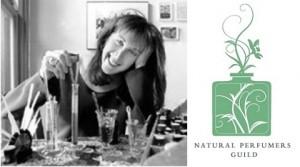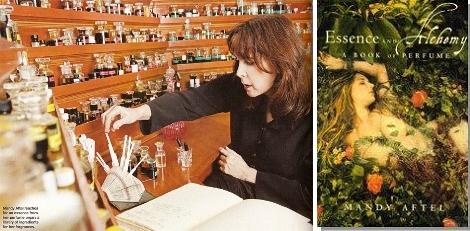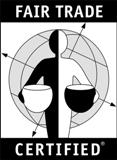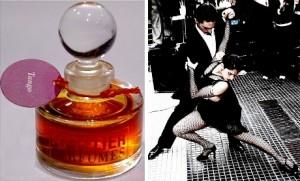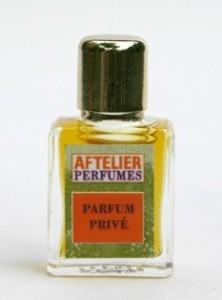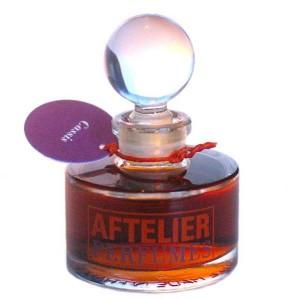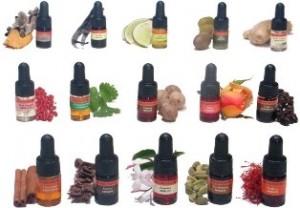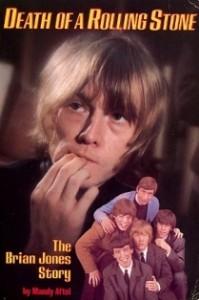The staff of CaFleureBon has been fans of Mandy’s for years and her popularity and legacy as the ‘Queen of Green’, continues to grow.
So to celebrate her beautifully designed new website www.aftelier.com, (here's a preview of the home page) we chose our favorites and one lucky winner will receive them all.
Leave a comment as to how Mandy Aftel ART has impacted you , about her beautifully re-designed website, nearly a year in the works and you are eligible to win the draw of all four !! This is important: you must leave a comment on her site as well as ours. if you have trouble getting your comment on Mandy's Site…try her facebook page and mention CaFleureBon
I had the honor to be one of the first perfumistos to interview Ms. Mandy Aftel in April of 2007, when natural perfumery was considered aromatherapy by traditionalists unwilling to accept this ancient art. Technology has changed our lives over the past three years faster than in the past thousand. There were no RSS feeds, nor Twitter and really, how many of you were on Facebook?
Mandy has told me that she considers this one of her favorite interviews; it’s mutual. Mandy, you are part of my fragrant past, present and future.
************************************************************************
An Interview with Mady Aftel: The Queen of Green
Long before we knew we were leaving carbon footprints, and when drinking bottled water was tres chic, Mandy Aftel, an independent perfumer, author of six books, including the “Bible of Botanicals”, Essence and Alchemy and the founder of the Artisan Natural Perfumers Guild was creating fragrances that used only 100% natural ingredients.
Most perfumers and corporations eschewed this methodology; natural and organic materials were expensive and volatile. The difficulties of obtaining only the finest ingredients, distilling essences and creating natural fragrances were not deterrents to Aftel’s mission – to disprove the popular belief that natural fragrances could never achieve the status of fine fragrances. Aftel founded Aftelier, her own company and pioneered the way for the dozens of new fragrances popping up, hyping that their scents are greener and cleaner. Many of these companies are touting their organic fragrances, claiming that they are certified by this organization or that, but few can stand up to the quality of Aftelier fragrances.
Formerly a psychotherapist and author, Aftel began her interest in perfumery just over ten years ago. She was researching the area for her next novel, where the main character was a perfumer. She recognized she had found her calling and started a revolution that we now take for granted as part of our environmentally conscious culture. In fact, one of the most interesting facts about Mandy that I discovered that she is working in conjunction with large corporations such as Glaxco-Smith and with Clean Well to develop ‘green’ scents for consumer products.
Mandy, you are an accomplished writer, a teacher and of course an award winning perfumer… when you hear people speak of MANDY AFTEL, what do you think?
MA: I don’t really think of ‘Mandy Aftel.’ I am very focused on my work and don’t really see myself from the outside. From the inside, I just feel so fortunate to be able to do the work I love – working with gorgeous essences and creating new fragrances.
You have been called the ‘Alice Waters’ of natural perfumes. You were there at the beginning when natural and botanical fragrances and oils were for ‘hippies’ and ‘treehuggers’. How do you feel years later, when everyone is plugging ‘green’?
MA: I couldn’t believe my good fortune at literally ‘following my nose’ and stumbling into natural perfume. At first I fell in love with the old perfume books – ones from the turn of the last century – and immediately after that I fell in love with the voluptuous, complicated, fecal-floral extraordinary natural essences. I wanted to write a novel about a perfumer and became one instead.
I am very pleased that people are interested in natural essences. There is pleasure in knowing that the scents are derived from particular plants and places – that they came from the earth. Much of what is described as natural is of course synthetic, but, as I learned in my research, that dishonesty has been going on for almost a hundred years, so it is nothing new. I genuinely believe that perfume buyers are interested in the beauty, authenticity, quality and complexity of natural essences and are becoming more educated about what they put on their body.
Can you define Natural Perfumery?
MA: A natural perfume is made only from pure and natural aromatics including essential oils, absolutes, concretes, CO2 extracts and resins. Natural Perfume can be considered art when constructed correctly, but it always made by hand.
For you Natural perfumery is a way of life. It has been your path for 15 YEARS. What do you think about the major fragrance houses and manufacturers new marketing tactics claiming to be all natural, organic, etc.?
I understand that most of the time their motivation has to do purely with maximizing profit without concern for the integrity of their ingredients and I think this is beginning to catch up with the perfume industry at large. I like that more attention is being brought to naturals and that their inherent virtues are being extolled, but not all manufacturers are actually using them. I would wish for more honesty in the perfume industry. The better educated consumers are, the more they will ask for their perfumes to be created with imagination from better quality ingredients.
Are there global or government standards in place that qualify a fragrance to be considered natural or organic. Is their a difference between natural and organic? I think many of us are really confused by some of the new terms we are hearing.
MA: This is a very confused and confusing issue. Everyone is jumping on the organic and natural bandwagon. I use fair trade ingredients — along with organic and wild-harvested whenever possible.
I have tried other natural perfumes and find they often turn sour or bitter as they drydown. Why is this?
MA: Natural perfumes that turn sour and bitter as they drydown are poorly constructed. Just because someone works with natural essences doesn’t mean that they can create a good perfume. One of the first things I say to my students is that “you cannot throw a bunch of beautiful natural essences into a beaker and call that a perfume.” First and foremost in working with natural essences is a thorough understanding of structure. The cornerstone of fragrance construction is around top, middle, and base notes. This cannot be modified and has to do with the amount of time an essence is perceptible on a scent strip. Top notes last ½ hour, middle notes 2 hours, and base notes up to a few days. A perfume is an art form that evolves in time.
I want to tell you and our readers, your scent Tango by Atelier actually brings tears to my eyes, as I immediately associate it with my maternal grandmother and her tale of two cites…Buenos Aries under the Junta. We, like many well respected 'noses' and 'perfumistas' consider it a masterpiece. What inspired you to create this complex and haunting fragrance?
MA: Thank you so much for your kind words and for sharing your memories. Tango was very very hard to create. I had to work on it for a long time and go through many versions until everything was right about it. It was built around choya, blond tobacco and coffee along with champaca absolute and wild sweet orange. I wanted the perfume to be like a night of naughty pleasures: dancing, drinking, smoking, coffee and sex. Choya is the smell of burst seashells – very intense, smoky and sultry, blond tobacco is warm, slightly sweet and smells like a cigarette or cigar before it is lit. Together they formed the base of the perfume – sweet, musky, and heavy. Champaca is rich and complicated fecal floral but also sweet and the coffee added a dirty edge to that voluptuousness. My wild sweet orange from the Dominican Republic is a very sophisticated high-register orange that just lifted the heaviness and added a fresh and wild aspect to the citrus at the top.
Parfum Prive is your latest scent and quite a departure from the collection. What is the story behind its creation?
MA: Someone had some old ambergris that they were willing to sell to me. Ambergris is possibly the most beautiful smell in the world and the rarest. I was so thrilled to be able to work with it that I created an accord of osmanthus flower, ambrette seed and orange flower absolute to build the perfume around. The rest of the formulation was in service of these four “break-the-bank” essences. I wanted something that was simply beautiful with a spiraling quality to it.
Are you working on a new fragrance now?
MA: I am working on a new perfume which will be called Cassis. I am challenged by the fact that all fruit essences are synthetic and it is extremely difficult to create a fruity perfume with all naturals. I want it to be light, buoyant and sophisticated
There is another side to your business that is directed towards the natural food industry and natural food enthusiasts. Briefly can you tell us about your Chef’s Essences and who purchases them?
MA: My Chef’s Essences are for use in cooking and they are sourced from all over the world. I take a great pleasure in sourcing my essences and will tend to sample at least five to ten versions of an oil before I am satisfied that I have found the one with the best odor profile and quality. Much like a good cook, I believe the final creation – be it food or perfume – can only be as good as the quality of the materials that it was created from. For example, my fresh ginger is a revelation – all ginger essential oils come from the dried root but this ginger is distilled from the wet rhizomes and has a light, citrus spicy aroma and tastes like the freshly grated ginger. Many restaurants, cookbook authors and chefs buy my oils: Nobu and Blue Hill in New York, The French Laundry, Coi, and Bouchon in California, Bill Yosses, the pastry chef in The White House, Harold McGee, author of “On Food and Cooking,” and Rose Levy Beranbaum of “The Cake Bible.”
Does music, art, literature play a role in your creative process? If so, who are your muses?
MA: I always create perfumes with music on. Many people do not know this but my very first book was a biography about Brian Jones of the Rolling Stones. My muses are Bob Dylan, Leonard Cohen and Lucinda Williams. All three of them focus on affairs of the heart – love’s ecstasies and difficulties. For me, they often capture in a lyric some ephemera of a sensual and feeling-full life. They create beauty from these fleeting moments. This is my inspiration.
Aftelier Fragrances, Chef’s Essences, and so much more are available at www.aftelier.com . Mandy Aftel’s books can be purchased on www.amazon.com
Michelyn Camen, Editor-in- Chief
Editor's Note: WOW The interview looks so vintage, and its only 3 years old. Its totally intact; how I was tempted to add the CaFleureBon touch of fabulous images….
please visit scenthive.com http://tinyurl.com/37lqb8w for more opportunites to win and giving props to mandy and her body of work.

![headshot-300DPI[15]](https://cafleurebon.com//wp-content/uploads/2010/06/headshot-300DPI15-300x262.jpg)
